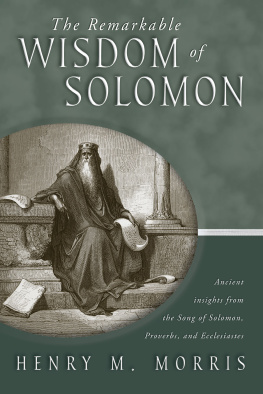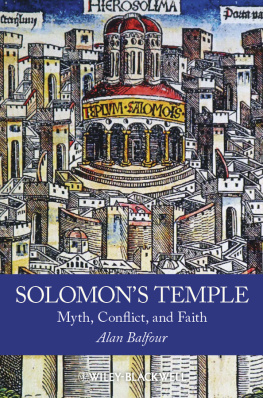ALSO BY ISRAEL FINKELSTEIN AND NEIL ASHER SILBERMAN
The Bible Unearthed: Archaeologys New Vision of Ancient Israel and the Origin of Its Sacred Texts

FREE PRESS
A Division of Simon & Schuster, Inc.
1230 Avenue of the Americas
New York, NY 10020
Copyright 2006 by Israel Finkelstein and Neil Asher Silberman
All rights reserved, including the right of reproduction in whole or in part in any form.
F REE P RESS and colophon are trademarks of Simon & Schuster, Inc.
The Library of Congress has cataloged the hardcover edition as follows:
Finkelstein, Israel.
David and Solomon: in search of the Bibles sacred kings and the roots of the western tradition / Israel Finkelstein and Neil Asher Silberman.
p. cm.
Includes bibliographic references and index.
1. BibleAntiquities. 2. Excavations (Archaeology)PalestineHistory. 3. ChristianityInfluence. 4. PalestineAntiquities.
BS621.F56 2006
222/.067 21 2005049490
ISBN-13: 978-1-4165-5688-6
ISBN-10: 1-4165-5688-5
Visit us on the World Wide Web:
http://www.SimonSays.com
DAVID AND SOLOMON
PROLOGUE
The Shepherd and the Slingstone
THE SMALL, REMOTE ELAH VALLEY IN SOUTHERN ISRAEL is a place of unique biblical inspiration. According to the famous account in 1 Samuel 17, its harsh, treeless landscape of open fields and low hills was the site of a dramatic confrontation that has remained vivid in the consciousness of the western world.
Even today, in the silence of the valley, one can still imagine the epic scene. On one side were the massed Philistine armies, heavily armored, confident, and ready for battle. On the other side was a volunteer force of Israelite peasants hastily mustered from their villages and sheepfolds, determined to defend their land and their faith.
The fearsome Philistine giant Goliath strode forward. Armed with a sword, javelin, and heavy spear and wearing a coat of mail and bronze helmet, he cursed his lightly armed Israelite opponents and challenged them to choose a single warrior to fight him: If he is able to fight with me and kill me, Goliath thundered, then we will be your servants; but if I prevail against him and kill him, then you shall be our servants and serve us.
For forty days, the Philistine giant emerged from the ranks of his waiting army and shouted out his challenge. The Israelites were dismayed and greatly afraid and none dared to take it up. Yet a handsome young shepherd named David, who had been sent to the battlefield by his father to bring provisions to his older brothers, suddenly arose as an unlikely savior. Armed only with a shepherds staff and a bag of slingstones, he approached the mighty Goliath. The arrogant Philistine laughed in scorn at his puny opponent, but David held his ground and boldly proclaimed: You come to me with a sword and with a spear and with a javelin; but I come to you in the name of the Lord of hosts, the God of the armies of Israel, whom you have defied. David then took a stone from his pouch and slung it. The stone struck the towering giant squarely in the forehead, and Goliath fell to the ground with a thud.
When the Philistines saw that their great champion had been killed by the young shepherd, they fled in panic. David snatched Goliaths sword and used it to take the giants head as a trophy of Israels great victory. The men of Israel and Judah rose with a shout and pursued the retreating Philistines all the way back to their own territory. The threat to the independence of Israel had been decisively answered, and Davids divinely guided career as defender, leader, and ultimately king of all Israel had begun.
The victory of David over Goliath is one of the most memorable scenes in the Bible, yet it arouses many intriguing questions: Did it really happen? Can we consider it to be a reliable historical account? Was the story written in the time of David or many years later? Is there any way of determining when it was composed? Can we detect hidden layers in the story? Why does the Bible, in an often-overlooked passage, credit another hero with the killing of Goliath? Why does the story so strongly resemble Homeric descriptions of mythic duels between Greek and Trojan heroes? Is it just a simple tale or does it conceal the circumstances and motivation for its composition? What is its wider significance for understanding the evolution of Judeo-Christian theology?
This book seeks to answer all these questions, not only for David and Goliath, but for the entire story of David and his son Solomon and their fabled careers. For the biblical tale of David and Solomon has been read for many centuries as a lesson about how courage, faith, and wisdom can redeem a people from oppression and establish their independence and prosperity. These are the twin goals that every people longs for and that every just leader strives to attain. The story of David and Solomons establishment of a powerful, prosperous United Monarchy of Israel has provided a model of righteous leadership enshrined in the Judeo-Christian tradition and in every society that has drawn its moral authority from it. The value of examining this biblical saga is thus twofold. It can reveal the stages of the authorship of the Hebrew Bible (and the use of its images in the New Testament) over a span of almost a thousand years. It can also help to explain why the images of David and Solomon have beenand remainso powerful in the western tradition by uncovering the historical reasons why the story developed as it did.
Our challenge will be to provide a new perspective on the David and Solomon story by presenting the flood of new archaeological information about the rise and development of the ancient society in which the biblical tale was formed. We will attempt to separate history from myth; old memories from later elaboration; facts from royal propaganda to trace the evolution of the David and Solomon narrative from its ancient origins to the final compilation of the biblical accounts. By following this path, our search for David and Solomon will reveal the fascinating tension between historical fact and sanctified tradition; in this case, between the reality of Iron Age Judah and the Wests still-living legend of ancient Israels sacred kings.
INTRODUCTION
David, Solomon, and the Western Tradition
Ancient Legends, the Bible, and Archaeology
FROM THE SOARING CATHEDRALS AND ELEGANT PALACES of medieval Europe, to the hushed galleries of world famous art museums, to Americas backwoods pulpits and Hollywood epics, the story of ancient Israels sacred kings, David and Solomon, is one of western civilizations most enduring legacies. The figures of Davidshepherd, warrior, and divinely protected kingand of his son Solomongreat builder, wise judge, and serene ruler of a vast empirehave become timeless models of righteous leadership under Gods sanction. They have shaped western images of kingship and served as models of royal piety, messianic expectation, and national destiny.
Thanks to archaeology, we nowfor the first timecan dissect the main elements of the biblical story to see when and how each one emerged. The results of our search may be surprising, for the archaeological discoveries of recent decades have clearly shown how far from the glamorous scriptural portraits the actual world of David and Solomon was. Yet the legend was not merely a romantic fiction of imaginary personalities and events. It evolved over centuries from a core of authentic memories into a complex and timeless literary creation. In its unforgettable images and dramatic scenesthe battle against Goliath, the rise of David from outlaw to king, the splendor of Solomons courtthe legend of David and Solomon expresses a universal message of national independence and transcendent religious values that people all over the world have come to regard as their own. Yet as we will see, its origins are traceable in the archaeology and history of a single small Iron Age kingdom as it grew from a village society into a complex state.












